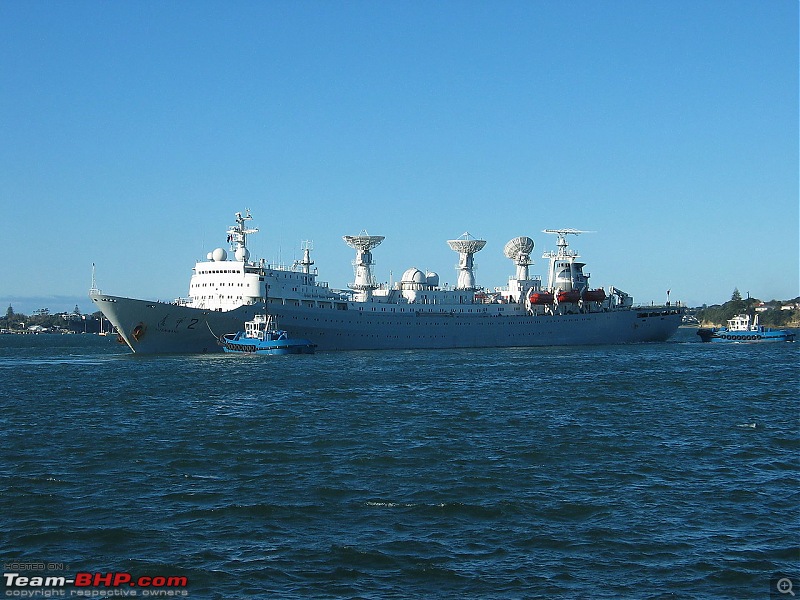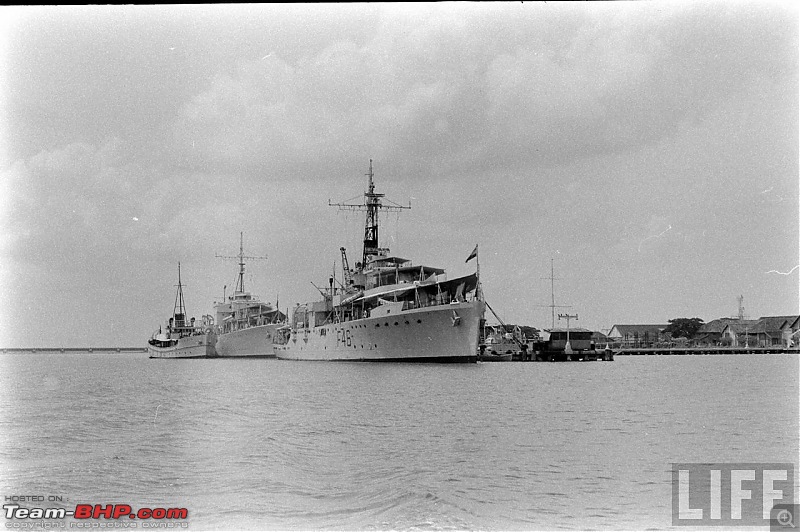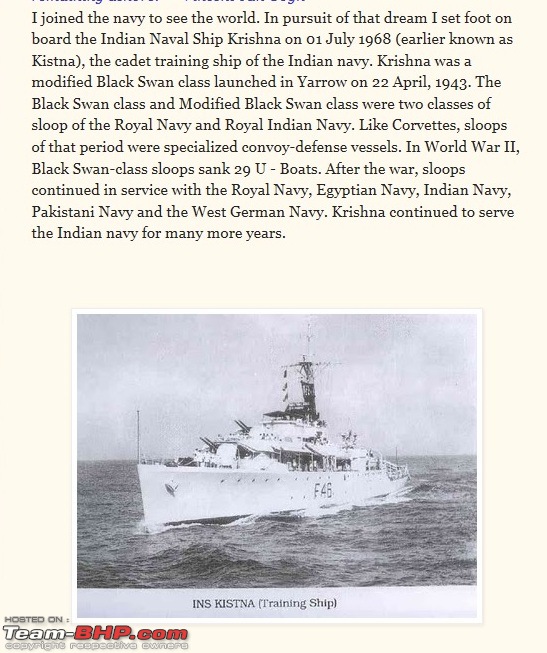Team-BHP
(
https://www.team-bhp.com/forum/)
Indian Navy informs government about the fleet's reoriented mission pattern
By Sujan Dutta | Express News Service | Published: 01st April 2018 01:15 AM |
http://www.newindianexpress.com/nati...n-1795404.html Quote:
Excerpts…….
Ten months since it reoriented the mission pattern of its fleet, the Navy has told the government it has the Indian Ocean covered with an alphabet soup of acronyms. GULFDEP to MALDEP is the new naval lingo to describe the Indian Navy’s area of responsibility.
The re-orientation to “Mission based deployments” (MDP) has meant that nearly 15 warships of the Indian Navy are patrolling seven areas of the waters around India, beyond the country’s Exclusive Economic Zone (EEZ), keeping an eye on all entry and exit routes to and from the Indian Ocean.
The ships are tasked round-the-clock, round-the-year. Each warship is turned around after three months.
Many of the Sea Lanes of Communications (SLOCs) that international mercantile marine traverses also sit astride part of China’s vaunted “Maritime Silk Road” from the South China Sea to Africa. Nearly 80 per cent of China’s energy supplies go through these routes.
The seven deployments are:
MALDEP: An IN ship is permanently sailing near the mouths of the Straits of Malacca
NORDEP: patrolling of the North Bay of Bengal, in waters north of the Andamans and the coasts of Bangladesh and Myanmar
ANDEP: patrolling between the North Andamans and South Nicobar
GULFDEP: patrolling of the North Arabian Sea and the approaches to the Strait of Hormuz and the Persian Gulf
POGDEP: anti-piracy patrolling of the Gulf of Aden, the oldest of the missions
CENDEP: patrolling in waters south of India, off the Maldives and Sri Lanka
IODEP: patrolling in the South Indian Ocean, off Mauritius, the Seychelles and Madagascar.
In addition to these deployments, Long Range Maritime Reconnaissance (LRMR) aircraft – the Boeing-made Poseidon P-8I planes – are tasked with flying sorties, sometimes up to the South China Sea, almost every day, from INS Rajali in Arakonnam, Tamil Nadu.
“We have the Indian Ocean covered,” a top officer overseeing the deployments told The Sunday Standard/The New Indian Express this week. “From GULFDEP to MALDEP, we can see every Chinese vessel, most certainly,” he said.
In December, the navy chief, Admiral Sunil Lanba had said that at least eight ships of the PLAN were in the Indian Ocean Region “at any given time”. These included three for their anti-piracy patrol that China too began in 2008. Twice a year, PLAN submarines criss-crossed waters close to India in an anti-piracy deployment that befuddles most navies. It is not understood why submarines should be used as platforms to counter piracy off the Horn of Africa.
|
Good to see we are taking the first steps towards being a mature naval force with defined permanent patrol areas. The fleet strength will need enhancements to sustain this. A naval warship is the last 400 feet of your foreign policy. It can achieve and deter by simply showing up.
Reading this article on the INS Khukri, the only ship we lost during the '71 war was a poignant experience.
The INS Khukri
Capt. Mulla, while much senior to Papa, was known to him they being of the same generation of IN officers. My brother and I were small children during this war.
Immense respect for you & your family Capt. Mulla, Sir. May you eternally RIP.
^^^^^
R2D2, thank you very very much for sharing this. It helps the younger Indians know a little more of their country and that there is more to India than just the unscrupulous politician or inept cop. The article in the link has been written in a balanced manner without jingoism and pseudo nationalism. Mulla I do not remember though my parents knew them well. But VK Jain and Rishi Raj Sood I recall very well.
For those readers who are interested. The Pakistani Daphne class submarine was state of the art for a diesel-electric boat in 1971. INS Khukri was a Blackwood class 2nd rate frigate of a late 1940s-design era. It's sensor range was 1500 metres and its weapon range was 900 metres. It stood no chance against PNS Hangor's 8,000 metre range homing torpedos. All our warships were out at Karachi or off East Pakistan and the sub was deemed a threat to Bombay harbour & shipping so INS Khukri & INS Kirpan, as last reserves, were sent.
At that time word reached Navy Nagar through the galley wireless that one ship had gone under but the Navy wasn't saying which one. There was much consternation amongst the families. Then a couple of days later the name was released to the grief of the bereaved families.
Some more poignant reading related to Capt Mulla and his family - his last letter to his daughter Ameeta then aged 14. She's currently the Principal of the Springdale School in New Delhi.
Capt. Mulla's last letter to his daughter Ameeta
Papa talked about Capt Mulla & the INS Khukri when my brother and I were slightly older in the late '70s (we were back in Mumbai or Bombay as it was called then) and able to at grasp, at least in bits & pieces, the enormity of that war and its aftermath in the Indian sub-continent.
PS - just wanted to share that I met my friend & classmate an ex Army veteran from the Armoured Corp last night over dinner with others from my school and college. He suffered a bullet injury in Siachen back in the early '90s and had to take premature retirement on health grounds. Although most of the previous evening was spent recounting our younger days and the mischief we were predisposed to doing once the retired Army Major began recounting his experiences at the frontline we all paid rapt attention. Serves to boost your respect for those who serve this country in unbelievably harsh conditions. I come from a family that has had 3 consecutive generations in the Defence Services. So these stories just strike very close to home.
Quote:
Originally Posted by R2D2
(Post 4444800)
Reading this article on the INS Khukri, the only ship we lost during the '71 war was a poignant experience. The INS Khukri
Capt. Mulla, while much senior to Papa, was known to him they being of the same generation of IN officers. My brother and I were small children during this war.
Immense respect for you & your family Capt. Mulla, Sir. May you eternally RIP.
|
Thanks. I borrowed a book last year on the subject of INS Khukri, and read it 3 times, after which I lent it to my brother. It has very interesting details in it. It even has the view of the Pak Submarine Captain in it. He says he missed targeting the huge fleet of the Indian Navy that were headed to Karachi. And this was close to Bombay. He also says when his sub had surfaced in the night to fix some issues, the Indian frigates that were headed to Karachi came very close to detecting his sub.
Strongly recommended for lovers of battle stories.
Some lovely historical pictures of the old INS Mysore Colony class cruiser showing off her nine 6" guns. My father served on her in 1959. Note the massive gun director on top of and just behind the bridge and a second one just abaft the after mast. These directors of WW2 design were a combination of visual identification & tracking & range finder and co-ordination with the gun turrets via intercom. They also may have had some radio direction finding linkages but I know not. The support of eyeball Mk 1 was also needed to determine if the shot hit the target at all or not. Times have changed a lot!! Also note the tapered end of the hull shape. This was called a cruiser stern and in the first half of the 20th century was believed to give a large warship greater steaming endurance. These days you'll see most warships have a flat square stern. I do not know why her number has been painted over.
Talwar class Frigates
INS Talwar, INS Trishul, INS Tabar, INS Teg, INS Tarkash, INS Trikhand
In my opinion the most handsome and well proportioned ship to serve the Indian Navy though the Delhi class destroyers could give it completion in this department.
A few delightful photos to savour.
Displacement:~4000 tonnes
Length: ~410 feet (125 metres)
Powerplant: 2 boost gas turbines of ~22,000 shp each plus 2 cruise gas turbines of ~9,800 shp each giving a total COGAG output of ~64,000 shp
Speed:32 knots+ ; Endurance: typically 30 to 45 days
Armament: Shitl SAM launcher. Range believed to be ~30kms
8 x Brahmos cruise missiles (anti-ship and land attack) Range ~290kms.
1 x 100 mm dual purpose gun
2 x 30mm ADG630 gatling CiWS {close in weapon system} for last ditch anti-missile defence
1 Anti-submarine rocket launcher
2 Anti-submarine 533mm torpedo tubes
1 Kamov Ka-28 anti-submarine chopper
India’s first missile tracking ship is readying for sea trials Quote:
India’s first missile tracking ship is readying for sea trials by Santosh Patnaik / September 11, 2018 / The Hindu
This will be the first of its kind ocean surveillance ship being built as part of the efforts under the NDA government to strengthen the country’s strategic weapons programme. This will be the first of its kind ocean surveillance ship being built as part of the efforts under the NDA government to strengthen the country’s strategic weapons programme.
Built by Hindustan Shipyard Ltd., the hi-tech vessel will enter elite global club. Once ready, it will be India’s first, a force multiplier and cruise the country into a global elite club. Hindustan Shipyard Limited (HSL) is gearing up to undertake sea trials of India’s first missile tracking ship by the first week of October.
The keel of the ship, which was laid on June 30, 2014, is being built for the National Technical Research Organisation, the technical intelligence agency working directly under the supervision of the Prime Minister’s Office and the National Security Adviser.Considered a “topmost secret project”, a lot of confidentiality is being maintained in executing the project costing about ₹750 crore. It will be named after its induction into the Indian Navy.
This will be the first of its kind ocean surveillance ship being built as part of the efforts under the NDA government to strengthen the country’s strategic weapons programme. When asked about the commencement of sea trials, HSL Chairman and Managing Director Rear Admiral L.V. Sarat Babu told The Hindu that the sea trials would be carried out either by September-end or the first week of October and they were confident of handing over the vessel to the Indian Navy by the year-end. “This would put India in the elite of club of a few countries that have such a sophisticated ocean surveillance ship,” the Rear Admiral pointed out.
|
Specialist vessels like these are used for tracking and measuring the flight performance, electronic performance and other parameter of test missiles. Why the sea. Because all countries developing medium to long range missiles test them [without warheads of course] by launching them out to sea where they fall harmlessly on a dummy target or theoretical target area. USA, Russia, France and China employ such ships.
Link:
https://www.thehindu.com/sci-tech/sc...le24929012.ece
Quote:
Originally Posted by V.Narayan
(Post 4463566)
[b]]
Specialist vessels like these are used for tracking and measuring the flight performance, electronic performance and other parameter of test missiles. Why the sea. Because all countries developing medium to long range missiles test them [without warheads of course] by launching them out to sea where they fall harmlessly on a dummy target or theoretical target area.
|
Interesting.
So this is not the combat ship; it's speciality lies in the missile tracking instrumentation onboard. Then why is it necessary to build a new ship instead of taking an old ship and fitting the instrumentation on the same? After all, such ship is not 'on duty' everyday.
Quote:
Originally Posted by Rahul Bhalgat
(Post 4463608)
Then why is it necessary to build a new ship instead of taking an old ship and fitting the instrumentation on the same? After all, such ship is not 'on duty' everyday.
|
Thank you for your question. The cost of designing and building a new ship is often competitive with redesigning, opening up and rebuilding an old one. Also a new ship will serve you for 30 to 35 years. An old one will take
as long to rebuild and will need a replacement after say 10 or 15 years.
For a deeply specialized vessel like this the cost and complications of conversion are in my opinion greater and messier. A ship is uniquely designed for its stated function - a destroyer or a helicopter carrier or a supply ship or whatever. Internal compartmentation, available volume, centre of gravity, stability, size of engines versus space for payload, positioning of equipment, top weight it can handle without capsizing etc all are unique to the role. For example a specialist ship like this needs - low speed [so less space occupied by the engines], it will carry tall masts and top heavy radars & dish antennae which will decide hull shape and stability and centre of gravity/centre of buoyancy which would be chalk and cheese compared to a destroyer or even a cargo ship for example. Like it is easier to build a factory than to convert a residential complex into one - similarly. Hope this helps.
Only the US went in for conversions of existing cargo ships. France, China and Russia went for new build like us.
China's....

France's....

Quote:
Originally Posted by Rahul Bhalgat
(Post 4463608)
Interesting.
So this is not the combat ship; it's speciality lies in the missile tracking instrumentation onboard. Then why is it necessary to build a new ship instead of taking an old ship and fitting the instrumentation on the same? After all, such ship is not 'on duty' everyday.
|
You have a point there.
But the ground up design could be because retrofitting is not as beneficial as a brand new one.
I am just indulging in conjecture here - there would be additional security features built into this vessel for e.g. low profile i.e. a semi-stealth ship, engine, propulsion and hydrodynamic design could have been as to be difficult to spot via radar or sonar. Remember I am just guessing here and given the secrecy of this project I am quite sure the authorities have more than a few tricks up their sleeve(s).

 "F-46" at Cochin, ca 1957
"F-46" at Cochin, ca 1957. I could not identify the name by the Pennant number.
Quote:
Originally Posted by travancore
(Post 4471947)
|
Thanks. Very clear & good quality pictures. From the looks I believe the first vessel is a Black Swan class sloop. As some of you may know the British in WW2 brought in this category 'sloop' to designate a 2nd rate frigate mainly focused on convoy escort and ASW warfare. HMIS Kistna carried the pennant U46 in WW2 serving with the RIN. In the 1950s the IN adopted F for the small & medium warships and probably this is Kistna flying F46 instead of U46. My best educated guess. Wikipedia claims after '47 she was renamed Krisna but none of my IN books of that era say so nor does my 1968 Jane's Fighting Ship directory support it. That's the problem with Wikipedia.
These were low cost hurriedly built ships built to economy in WW2. Their engines were steam turbines delivering only ~4200 shp for a 20 knot turn of speed.
On another note, I was just browsing the Twitter ticker bar on LiveFist where I stumbled upon this tweet ostensibly with an image of INS Vikramaditya in dry dock. But more interestingly it appears to have INS Vikrant (IAC-1) in frame as well.
https://twitter.com/zone5aviation/st...2Fread-this%2F
Haven't seen or heard about the new ship in a while so found this quite fascinating. One thing that bothers me, but I suspect is to do with perspective mainly is how the ramp looks asymmetric. I do hope it's just a consequence of the angle of the image. Other than that its looking decent. The island on Vikramaditya being so far off the starboard edge always bothered me too as wasted space, so good to see that the island on Vikrant looks nigh on indistinguishable here. Big flight deck, very squarish almost. In fact it very much reminds me of the new HMS Queen Elizabeth (that seems to have the most enormous squared off deck..though probably because the Royal Navy barely have enough stuff to put on there..)
| All times are GMT +5.5. The time now is 22:54. | |




